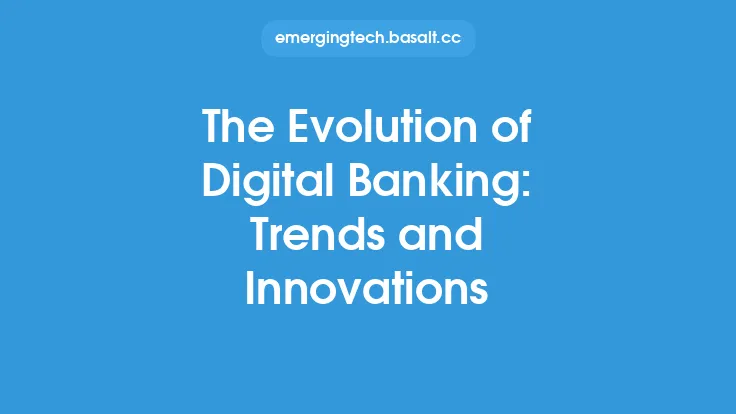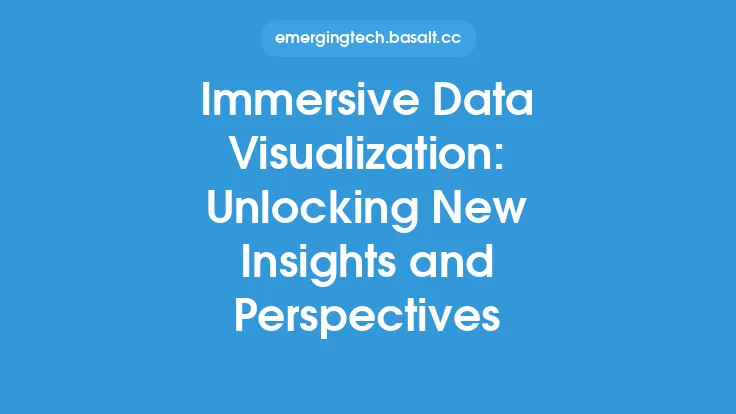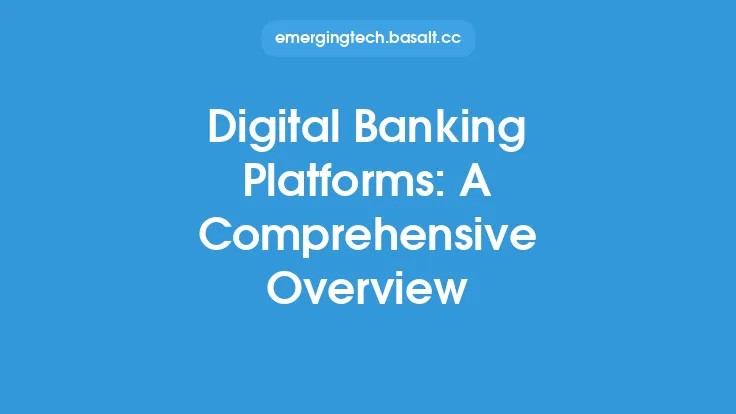The advent of digital banking has revolutionized the way financial institutions operate, interact with customers, and make informed business decisions. At the heart of this transformation is the strategic use of data analytics, which enables banks to unlock valuable business insights, enhance customer experiences, and drive growth. In this article, we will delve into the world of digital banking and data analytics, exploring the concepts, tools, and techniques that are redefining the financial services landscape.
Introduction to Digital Banking
Digital banking refers to the provision of banking services over the internet, mobile devices, or other digital channels. This shift towards digitalization has been driven by advances in technology, changing consumer behaviors, and the need for financial institutions to remain competitive. Digital banking encompasses a range of services, including online account management, mobile payments, digital wallets, and personalized financial advice. By leveraging digital channels, banks can reduce costs, improve efficiency, and expand their reach to a wider customer base.
The Role of Data Analytics in Digital Banking
Data analytics plays a vital role in digital banking, enabling financial institutions to extract insights from large datasets and make data-driven decisions. The use of data analytics in digital banking involves the application of statistical and computational methods to identify patterns, trends, and correlations within customer data. This information can be used to inform product development, risk management, marketing strategies, and customer engagement initiatives. By analyzing data on customer behavior, preferences, and financial transactions, banks can create personalized experiences, improve customer retention, and identify new business opportunities.
Types of Data Analytics in Digital Banking
There are several types of data analytics used in digital banking, including:
- Descriptive analytics: This involves analyzing historical data to identify trends, patterns, and correlations. Descriptive analytics provides insights into what has happened in the past, enabling banks to understand customer behavior, transaction patterns, and market trends.
- Predictive analytics: This involves using statistical models and machine learning algorithms to forecast future events or behaviors. Predictive analytics enables banks to predict customer churn, credit risk, and fraud, allowing them to take proactive measures to mitigate these risks.
- Prescriptive analytics: This involves using data analytics to recommend specific actions or decisions. Prescriptive analytics provides banks with actionable insights, enabling them to optimize business processes, improve customer experiences, and drive revenue growth.
Data Analytics Tools and Techniques
A range of data analytics tools and techniques are used in digital banking, including:
- Data warehousing: This involves storing large datasets in a centralized repository, enabling banks to integrate data from multiple sources and perform complex analytics.
- Business intelligence: This involves using software applications to analyze data and create visualizations, reports, and dashboards. Business intelligence tools provide banks with real-time insights into customer behavior, financial performance, and market trends.
- Machine learning: This involves using algorithms to identify patterns and make predictions. Machine learning is used in digital banking to detect fraud, predict customer churn, and personalize marketing campaigns.
- Big data analytics: This involves analyzing large, complex datasets to identify insights and patterns. Big data analytics is used in digital banking to analyze customer behavior, transaction data, and market trends.
Applications of Data Analytics in Digital Banking
Data analytics has a wide range of applications in digital banking, including:
- Customer segmentation: This involves using data analytics to identify customer segments and create personalized experiences. Customer segmentation enables banks to tailor their products, services, and marketing campaigns to specific customer groups.
- Risk management: This involves using data analytics to identify and mitigate risks. Risk management is critical in digital banking, where banks must balance the need to provide convenient services with the need to protect customers from fraud and cyber threats.
- Marketing optimization: This involves using data analytics to optimize marketing campaigns and improve customer engagement. Marketing optimization enables banks to target specific customer segments, measure the effectiveness of marketing campaigns, and adjust their strategies accordingly.
- Operational efficiency: This involves using data analytics to optimize business processes and improve operational efficiency. Operational efficiency is critical in digital banking, where banks must process large volumes of transactions, manage complex systems, and maintain high levels of customer service.
Challenges and Limitations of Data Analytics in Digital Banking
While data analytics offers numerous benefits in digital banking, there are also challenges and limitations to consider. These include:
- Data quality: This refers to the accuracy, completeness, and consistency of customer data. Poor data quality can lead to inaccurate insights, incorrect decisions, and reduced customer trust.
- Data security: This refers to the protection of customer data from cyber threats and unauthorized access. Data security is critical in digital banking, where banks must protect sensitive customer information and maintain the trust of their customers.
- Regulatory compliance: This refers to the need for banks to comply with regulatory requirements and industry standards. Regulatory compliance is critical in digital banking, where banks must navigate complex regulatory environments and maintain high levels of transparency and accountability.
- Talent and skills: This refers to the need for banks to attract and retain skilled data analysts, scientists, and engineers. Talent and skills are critical in digital banking, where banks must compete for top talent and maintain high levels of expertise in data analytics and related fields.
Conclusion
In conclusion, digital banking and data analytics are revolutionizing the financial services landscape, enabling banks to unlock valuable business insights, enhance customer experiences, and drive growth. By leveraging data analytics tools and techniques, banks can create personalized experiences, improve customer retention, and identify new business opportunities. However, there are also challenges and limitations to consider, including data quality, data security, regulatory compliance, and talent and skills. As the financial services landscape continues to evolve, it is likely that data analytics will play an increasingly important role in digital banking, enabling banks to stay competitive, innovative, and customer-centric.





